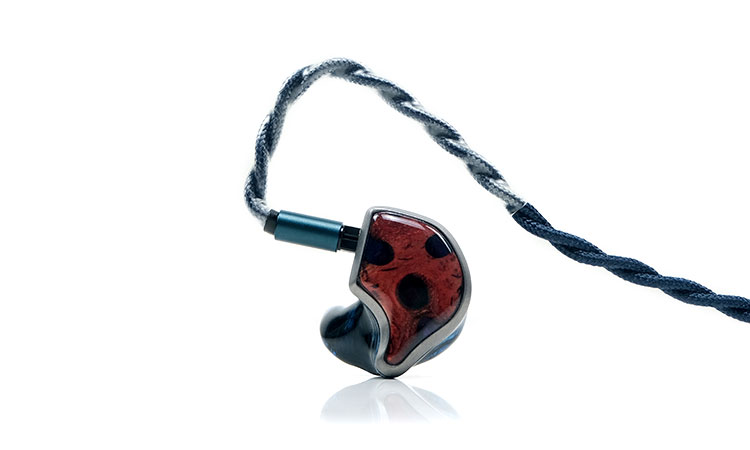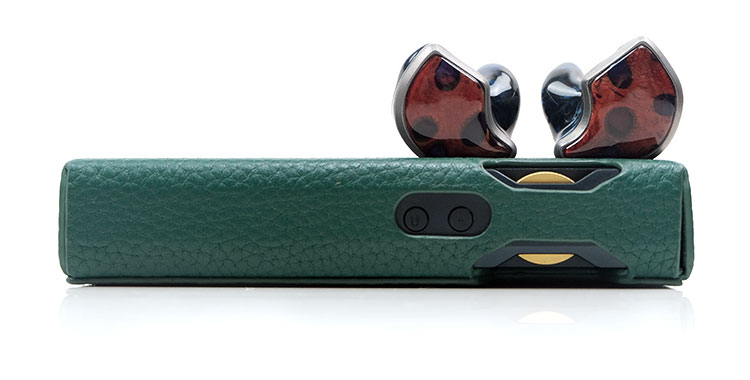Sound Impressions
Summary
The Unique Melody Multiverse Mentor has one of the most unique and compelling sound signatures I have heard out of a custom monitor to date.
Not so much in the w-shaped frequency response, which is actually what you might describe as being a very coherent and balanced sounding. Rather, it’s the bone conduction driver, combined with enormous technical capability that makes the Multiverse Mentor a world-class performer.
I have heard plenty of BA-implemented woofer presentations, and some are amplified much more than the Mentor’s own low-end FR.
However, they sound like traditional BA woofers in their delivery with plenty of punch but are still relatively light in terms of density, nothing really that close to the shuddering weight from a dynamic driver when it slams at full tilt.
Not so with the Multiverse Mentor. The textured detail, density, and resulting fundamental is probably one of the best I have heard from a BA monitor’s low-end. It hits differently from the likes of the Maven Pro or the Sharona which are also quad-BA woofer-based designs. There is less volume than those two but sounds firmer, better defined, and more life-like in its delivery.
And it’s a sneaky so-and-so also. The Mentor’s bass hits hard when required but it’s not omnipotent throughout so you might not ‘get it’ until suddenly out of nowhere you get incredible depth and weight on lower register notes.
And that is just one aspect of the Multiverse Mentor. The other salient quality is staging, particularly so with any source known for big presentations such as the Cayin N8ii or the Cayin N7.
The holographic capability combined with the BA prowess for speedy articulation and sharp imaging is incredibly immersive. This is a precision ‘machine’ at its finest but also one without any analytical dryness.
Frequency Response
Some might call the Multiverse Mentor tuning u-shaped but I see it as more of a gentle W-shaped response curve with very little in the way of excessive or uneven bumps and valleys throughout.
It is not as bloated or elevated as some of the competition on the low end with a relatively linear sub-bass to mid-bass plateau and a classic dip from around 100Hz down and into the mids up to 800Hz.
Perhaps slightly favoring mid-bass if anything which is unsurprising given its BA composition but the propensity to go lower is more tactile for me than those BA woofers without bone conduction. UM has resisted going for outright bass amplitude and perhaps bone conduction was the missing ingredient to allow them to do that.
Some pinna gain is there from 1-3k but it’s more on the milder side than excessively forward sounding. It’s just the right balance imaging-wise with copious amounts of space to add to the perception of generally large staging quality.
There is a little bit of a suck out in the upper-mids to lower treble transition around 4-5k which seems to clamp down on excessive energy and adds more natural warmth into higher pitching percussion and synth notes.
This is compensated though with a larger 8-10k bump that keeps a bit of sparkle and clarity and helps shine a light on its excellent extension and headroom.
Timbre
The Multiverse Mentor has a wonderfully natural quality to its timbre. If you are expecting a dry or analytical quality to its multiple BA arrangement then think again. At times it has an almost analog quality to note timbre yet at the same time the textural detail in each note is outstanding.
Especially the bass notes that have a shockingly good fundamental for BA subwoofers. Not Legend EVO Weapon IX+ dynamic driver woofer level but the solidity and definition are much more life-like than a typical armature low-end response.
There is nothing polite about the performance but at the same time, the speed is not lost in delivering that weight and definition. Key to that is space and a necessary dip into the lower mids to thin out any potential bloat mask which could suffocate the delicately balanced mids pinna gain.
Mids to me are natural and life-like in their delivery with a nice level of weight supported by an above-average fundamental in lower-mid instrumental notes. At times I would almost argue they are flawless with a perfect harmonic balance between clarity and euphony.
The highs to me on the Multiverse Mentor custom version do not seem to play out like the descriptions of the universal version.
Some seem to find a little bit of sibilance to creep in with that 8k spike but for me, the custom version is beautifully balanced allowing the sparkle and upper-order harmonics to creep into instrumental timbre in a very natural and believable manner.
Staging & Dynamics
Wow, what an expansive soundstage and one that can hit surprisingly deep also. It also can deliver outstanding width and height without overemphasizing the treble forwardness to trick your aural senses into thinking there is some serious extension in the highs.
Does it hit as deep as those TOTL dynamic driver IEMs? No, and I want to be clear about that. The sub-bass presence is not exaggerated and there is a very slight bias to the mid-bass punch. But the quality of the deeper-reaching notes is the best I have heard to date from BA subwoofers.
The one IEM I can think of that challenges the Multiverse Mentor in terms of sheer size is the Noble Audio Viking Ragnar but that can come at the cost of some sizzling highs if the tip choice is not done with great care. You get none of that sizzle here.
It’s not just the macro but also the micro detail with superlative imaging. This is imaging that relies less on forced treble to highlight subtle cues and instead amplifies the space to deliver a very black background in which you can pick out every subtle note very easily.
Sources will affect the staging quality of the Multiverse Mentor. For example, the RS8 offers a bit more neutrality through the mids and bass whereas the Cayin N8ii gives vocal presence a more prominent role.
Newer models such as the Cayin N7 stretch the stage out wonderfully wide. Perhaps one of my favorite solid-state player pairings already for the Multiverse Mentor.
Synergy
Efficiency
The Unique Melody Multiverse Mentor has an impedance rating of 22Ω with an SPL of 114 dB @1KHz which means it’s not going to be difficult to drive from most quality DAPs and dongles that offer a balanced 4.4mm output. You will have to change to a 3rd party cable if you want to go to 3.5mm SE or 2.5mm TRRS.
In our comparison section I ran a little more sensitive compared to the Maven Pro but only by 1-2 volume steps using the balanced output of the HiBy RS8 and the Cayin N7 in low gain so barely negligible.
The gap between the other two compared custom monitors, the FiR Audio Krypton 5 and the JH Audio Sharona was also relatively small enough not to be too concerned about power.
Sensitively to background noise is also excellent, the Multiverse Mentor has an incredibly black background with the right source pairing such as the Cayin N7, (in both Class A and AB mode), and HiBy RS8.
Even an old Sony PCM-D100 recorder paired with the Multiverse Mentor on audio playback mode delivered a beautifully noise-free performance with good channel control on low volume.
Pairings
Since the Multiverse Mentor projects such a strong holographic staging performance, I had a distinct preference for sources that amplified that aspect of the presentation.
And secondly, a DAP that was able to add as much detail as possible into the improved BA woofer texture from the additional bone conductor driver also got my vote.
LP P6 Pro & Cayin N7
Two DAPs targeted each aspect beautifully. The flagship Luxury & Precision P6 Pro for the detail in the note texture and the new Cayin N7, (balanced 4.4mm output) for a pitch black background and expansive soundstage.
I had a hard time choosing between both but if your preference is to get every ounce out of that BA/Bone conductor bass response and produce a fleshy solid vocal note and imaging experience then the P6 Pro should get your vote.
If you want to expand the stage out in all directions, especially in terms of width then the N7 would be my preference.
Cayin N8ii
The Cayin N8ii did extremely well for vocal timbre as well as staging size, though it’s a different tonal quality to either of the aforementioned sources. This pairing will sweeten the Multiverse Mentor mids coloration and bring in a little more ‘bloom’ into the presentation at the same time.
The Cayin N8ii P+ mode also introduces a stronger level of slam and vibrancy for me when paired with the Mentor. You also get a more forward and immediate vocal image compared to the N7/Mentor pairing.
FiiO M17 & HiBy RS8
Two DAPs I was less fussed about with the Multiverse Mentor were the FiiO M17 and the HiBy RS8. The RS8 is technically excellent with the Mentor in terms of resolution, staging width, and headroom.
However, the bass and vocal imaging are too neutral, even with Turbo Mode, when compared to the aforementioned DAPs, and came across as a bit boring in its vocal delivery. I felt a bit disconnected from this matchup enjoyment-wise even though the level of detail I was hearing was superb.
The M17 had a bit more oomph about it but when tracks got busy with complex imaging coming to the fore it struggled to inject the same level of clarity and blackness into its background compared to the other sources.




